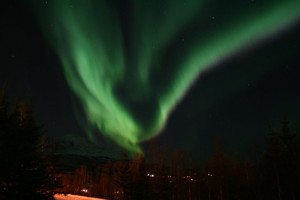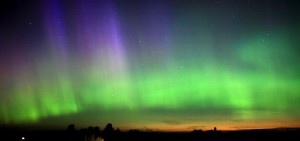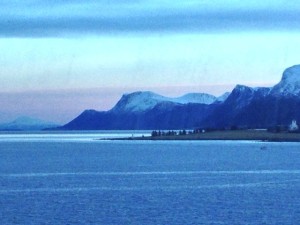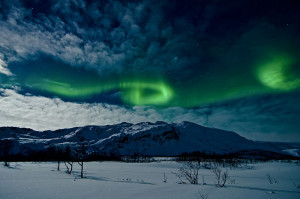Richard Lutz chases the Northern Lights off the coast of Norway.
From the minute the ferry leaves Bergen, all eyes are on the northern horizon. And no wonder.
Many of us have grabbed a ticket for the 2,500 mile round trip to the Arctic Circle simply to glimpse the Northern Lights at sea. So great is the demand in the winter months, so keen the interest that the captain even patches through on a tannoy to your cabin any time of the night if the lightshow even hints at emerging.
So, for instance, at 3.14 am, deep in sleep, lulled by the rocking of this ferry cum freighter, a clipped Norwegian accent will say: “The bridge wishes to inform all passengers that the lights may be on view off the port deck in approximately 7 minutes and 32 seconds.”
The Norwegians have a way with precision.
Then it is up to you to throw on four or five layers, chuck on your hat, your scarf, your ski gloves and your sense of duty and crowbar yourself outside into the knife edge of the sea-cold.
On the second night, we were told of the arrival of t he Aurora Borealis- those elusive shimmering lightshows that are caused by solar winds which fragment when they hit the natural shield of the earth’s atmosphere. Fortunately for us, it wasn’t the bruising 3.15am call but a more civilised 10pm. Even so, ripping yourself from an eye-wateringly priced litre of beer is still hard enough as the boat rolled off the Norwegian coast in a bitter wind, a wind so cold it seemed to have your name vindictively etched on its nose.
We went outside. At first, there was a grey cloud – a formless night cloud. But then it changed to a lurid twinkly green and then turned into a vertical funnel. Something akin to a cyclone. It formed, disappeared, and re-formed above our heads.
 Then it dipped as if plunging into the cold sea off the bow. But suddenly a fragment of the lower half of the tube broke away and flared into a small curtain. It changed from green to yellow, to pink and a hint of orange. Then the curtain shimmered and enlarged as if shocked and awakened by its own energy.
Then it dipped as if plunging into the cold sea off the bow. But suddenly a fragment of the lower half of the tube broke away and flared into a small curtain. It changed from green to yellow, to pink and a hint of orange. Then the curtain shimmered and enlarged as if shocked and awakened by its own energy.
There were the usual gasps and the flank of cameramen, who needed a 30 second exposure, got as narky and short-tempered as any chaotic press scrum. There were words. Cameramen can be testy sometimes. No…. sorry… all the time.
The lights continued to unscroll, flaring and changing colour as it spread across our bow. The northern sky was lit up.
Then as suddenly as it appeared, the curtain rolled up into the funnel again and flattened horizontally across the whole of the northern horizon…and then slowly tipped its hat and vanished.
Hello, Northern Lights. And probably a silent sigh of relief from the ferry owners who promised that the whole of the coastal trip from Bergen north to the Russian border would be refunded if no show was observed.
 Not that I would have felt unbloodied if I had lost out. I have seen this grand illusion of solar particles before, sparkling across the limitless sky.
Not that I would have felt unbloodied if I had lost out. I have seen this grand illusion of solar particles before, sparkling across the limitless sky.
The first time was on the American/Canadian border. But this ocean trip took the kaleidoscopic biscuit because it was at sea, on water, untainted by town lighting or cars. It added an unearthly dimension because, with a waning moon, there was a solid beam of moving water before us as we chased the colours in front of us.
So, we were twice blessed: if we weren’t hypnotised by the dance in the night sky, we were equally enchanted by the white ripple of sea that seemed to guide us north towards the whispering lights.
And north we headed. In its regular schedule up and down the Norwegian coast with its islands, fjords and mountains, the ferry lands at 35 ports northwards and the same coming back south.
So, on an 11 day trip, there are seventy stops – some for three hours to engage with a city such as Trondheim or Tromso and some for a mere ten minutes to unload a tractor at Rorvik, pick up a businessman at Norvik or unload sugar and take on a snowmobile at Torvik.
 But if these ports all had something in common, it was just how, no matter how big or tiny, they could be so neat, serviced and maintained after the general manginess of UK docklands.
But if these ports all had something in common, it was just how, no matter how big or tiny, they could be so neat, serviced and maintained after the general manginess of UK docklands.
The coastal economy bustled and hustled and noisily went about its business on these 70 stops.
Well, almost 70 stops…
The hurricane put an end to that number.
On the way back, gales were forecast, then strong gales, then violent storms and then the full whack with storm force 11 winds (75mph). We scarpered out of our port at Harstad and the captain headed to the nearest fjord for some peace and calm.
“Better to get out of port fast” he later told me, “There are too many problems there. And when the wind keeps changing, even the fjord is no good.”
So ‘no good’, in fact, that he slipped the safety of the inlet and chugged up and down in lazy loops in a wide bay just to keep control as the snow hit horizontally, the wind screamed and the boat rolled, pitched, yawed and then rolled again.
And with that evasive action, he also shook off a slew of port-of-calls. So out went Vardo, Risoyhamn, Sortland, Stokmarknes, Svolvaer, Stamsund, Ornes, Nesna and Kristiansund.
A day later, the hurricane blew itself out. Only a gentle Force 8 wind to contend with. Nothing really after a storm that can rip the heart out of a man at sea but really never put paid to the memory of the Aurora Borealis and its dance in a night sky.




Sounds beautiful
Lovely description of the North Lights, or Borealis Race as Burns called them. And great pictures. It all reads like a chapter out of Herman Melville. John Knox, Edinburgh.
gorgeous
ah you’ve done it again lad – inspired me to it the road (or sea) for parts unknown…